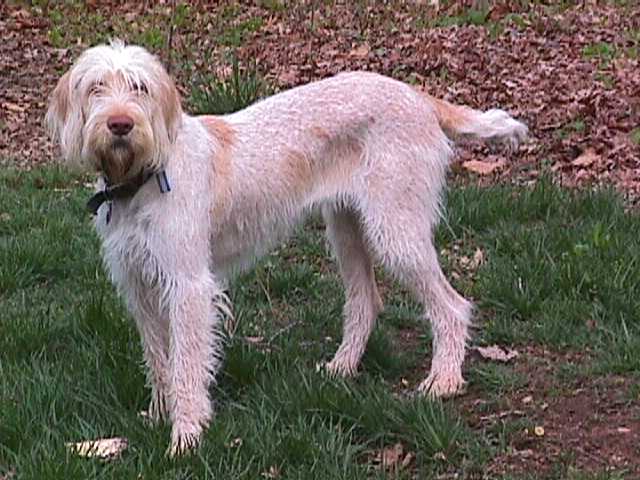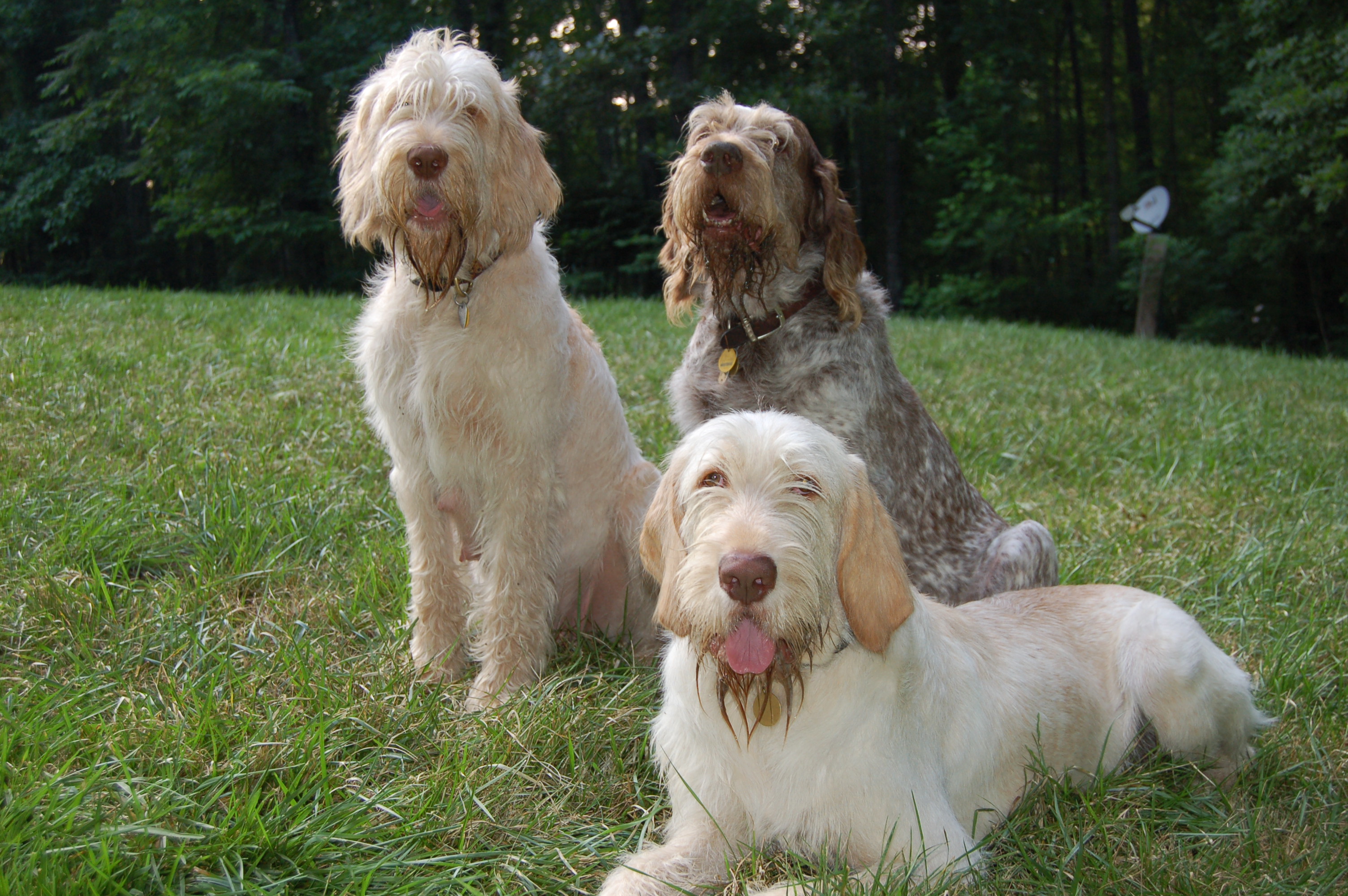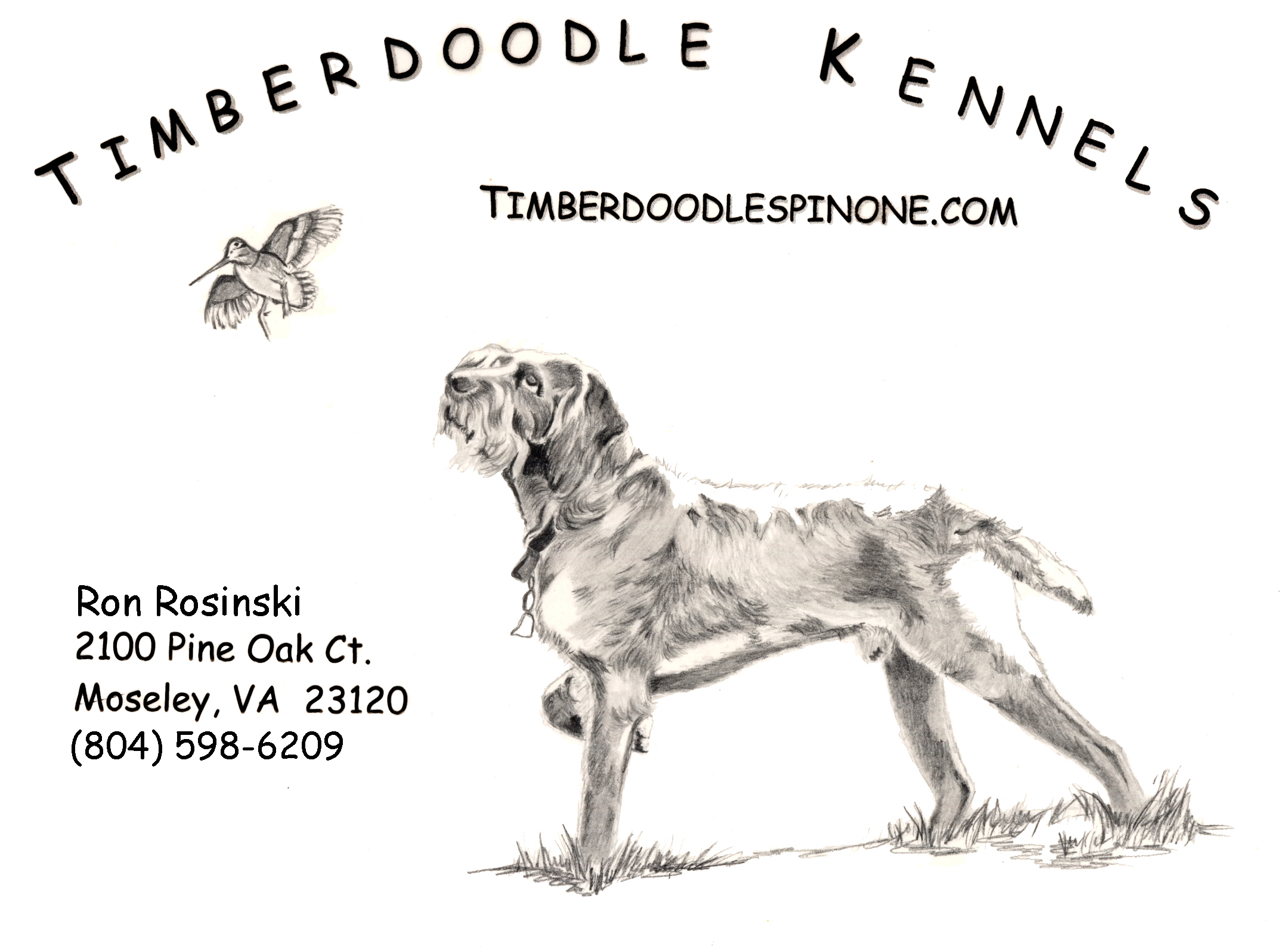 |
 |
 |
 |
 |
 |
 |
 |
 |
Home |
Information |
Links |
Pics |
Page |
Available |
Us |
Pictures |
the Heck Is a Timberdoodle?? |
 |
 |
 |
 |
 |
 |
 |
 |
 |
Home |
Information |
Links |
Pics |
Page |
Available |
Us |
Pictures |
the Heck Is a Timberdoodle?? |
 |
 |
 |
|||||||||||||||||||||||||||||||||||||||
|
HELPFUL INFO ABOUT MY BREED!!!
  THE SPINONE
 Answers to Your Questions.  GENERAL DESCRIPTION
The Spinoni Italiano, also known as the Spinone, Italian Spinone, or Italian Griffon is a large, rugged dog of distinctive appearance. He has a long head, with hanging ears and eyes described as "human like." In body he is a substantial, strong boned dog of square build. This deep-chested breed has a topline that slopes slightly up from below the withers to the muscular hindquarters. Everything about this breed indicates great strength as well as stamina. Suited for hunting in all climates and on all terrain. Its coat in fact protects it from the water and freezing temperatures of the swamp. It goes nonchalantly into cold, deep water, being an excellent swimmer and a model retriever.
Although not common in the U.S., this breed has a long history of service to man. His rather uncertain heritage centers around Europe and it's gun dogs of long ago. Whether he was the basis for bringing forth other gun breeds, or whether they simply sprang from common stock is not known.
Like all Italian breeds it is ancient. In Renaissance Italy a pointer with wiry hair was already present and reached us with much difficulty, due to extraneous crossbreedings performed heedlessly. After 1950 the breed was reconstructed by a few great breeders. Its innate merits are its sense of smell, setting, retrieving, recovering, and the close ties it has with the hunter.
The breed has excelled as a pointer and retriever for centuries. Today he is still a popular hunting dog in other countries, as well as pet. The United States seem to be at last discovering this versatile dog.
The Spinone's grumpy appearance contrasts with its gentle and affectionate disposition. It has a great capacity for learning and the desire to satisfy its master most completely. Very sociable, courageous, loyal and an excellent companion. Today the breed is popular not only in Italy but is also raised in England and Scandinavia. The Spinone has a marked tendency to trot broadly and swiftly.
CONFORMATION
Below is a brief discription of the Conformation/ Apperarance of the Spinone.
TEMPERAMENT AS PUPPY
As a youngster, the Spinoni displays a restless nature typical of the hunting breeds. There is nevertheless an underlying calm to this breed that is obvious to all who meet him. This is a lovable, sweet, affectionate puppy who quickly becomes devoted to his family. Said to have a natural caution with strangers. the Spinoni should be well socialized to prevent shyness. Those who have lived with this breed agree that he seems remarkably "tuned in" to his owner. Even in the field, the Spinoni's style is to work close to the hunter. He trusts his family implicitly, but once betrayed will never forget it. Very gentle training should begin early on, as he can occasionally be a bit obstinate. He is not one to challenge for pack position, and he is playful in all categories.
TEMPERAMENT AS ADOLESCENT
Not surprisingly he is most restless at this stage of growth, while his hormones sort themselves out. Still very loving and affectionate, he needs a great deal of attention from his family. This is not a breed to amuse himself, he needs interaction with those around him. When well socialized, he is generally cautious but friendly with strangers, taking a moment or two to size them up. Most are not aggressive with other dogs, though owners should always be alert when introductions are made. He remains playful in all categories.
TEMPERAMENT AS ADULT
As an adult, this breed puts his restless stage behind him, maturing into a fine companion, calm and very gentle. He can also be sensitive. His somewhat independent nature is offset by his kind, agreeable attitude toward the world. Centuries of serving and living closely with man has produced a breed that is docile yet vigorous, non-aggressive yet courageous, and friendly yet vigilant. He remains fairly playful all his life. As one breeder put it, "Always a puppy!" This noble dog is a credit to his heritage.
PERSONALITY
Happy, upbeat and enthusiastic, the Spinoni Italiano is a pleasant, easy-going breed. He is easily satisfied when treated as a member of the family. Although serious when at work in the field, he definitely has a clownish side that is often quite entertaining. Never bossy or whiny (unless constantly ignored), this gentle soul loves children, those he knows and those he does not. Children must be taught to treat this wonderful dog with the love and respect he deserves. His great patience should never be taken for granted--abuse is abuse, whether intentional or not. This breed gets along well with other animals, particularly enjoying the company of another dog. He wants to be with his people, whether that means at home or traveling, preferably in someone's lap!
POSSIBLE HEALTH PROBLEMS
Hip Dysplasia
Little data has been accumulated for the Spinone breed in general. Hip Dysplasia does exist, as in other comparably sized dogs
Cerebellar Ataxia a Genetic Disease identified in the Spinoni Italiani. This particular Cerebellar Ataxia is inherited as an autosomal recessive gene. This means that a puppy must have inherited a copy of the abnormal gene from both the sire and the dam for the puppy to display the disease. It means that both parents carried the gene, but did not suffer from the disease. A litter from a mating of two carriers will produce on average 25% puppies who will die of the disease, 50% who are well but are carriers and if mated will pass on the gene to 50% of their offspring, and 25% totally normal pups. GO TO THE HEALTH PAGE FOR MORE INFORMATION ON Cerebellar Ataxia.
COMMENTS
In spite of how wonderful this breed sounds, he is still not for everyone. For many active people, he would be too laid-back. For true couch potatoes, he needs too much exercise. For someone looking for a high in trial obedience dog, he lacks the flash. Some people would prefer a dog who is less needing of attention. Still, this breed does suit a great number of prospective owners. I have no doubt his popularity in this country will rise, hopefully slowly. The Spinoni may be a bit difficult to find, requiring interested parties to go on a waiting list. If this is truly the breed for you, it is worth the wait.
SPECIAL CONSIDERATIONS
The Spinone can be timid if not properly socialized. The "FEAR" impressionble stage is from 4 to 10 months of age. Be cautious about purchasing, or shipping a puppy at this age. It is recommended that you pick up your puppy personally if purchased during the "FEAR" impressionable stage rather than having the puppy shipped to you. In addition, if the puppy is kennel raised, he/she will be extremely fearful of "house noises" and probably not be "potty" trained. Be sure to ask if the puppy was house raised versus kennel raised.
It is also imperative to ask the breeder for the OFA (Orthopedic Foundation of America) or PENN HIP certification for the status of possible Hip Dysplasia of the Puppy's sire and dam, rather than merely a "reassurance" that the they have been x-rayed. For example, the English Breeders require that the animals be x-rayed, but they are not required to pass any particular standard.  Where are you located? 25 miles southwest of Richmond, Va. Do you ship puppies? No. But, you can take them as carry-on on most major airlines. Are there any temperment differences between males and females? There is a slightly more rascally temperment in the males, but, compared to most breeds, not a huge difference. Do they shed? We have 5 Spinoni so it's hard for us to judge; but, for the most part really not that bad. How do you groom them? Mostly by light combing and hand stripping. We don't recommend taking them to a groomer as most groomers have never even seen a Spinone. Do they do well with children and other critters? Absolutely. They love kids and get along with most critters. Birds........ that can be an issue; hey, they are bird dogs!! I don't hunt; will they still be ok as a companion? Although our preference is to hunters, we realize not everyone bird hunts. With that said, they are excellent companions and family members. But, being a strong, instinctual hunting breed, they do require room to run and exercise their hunting instincts. Not an apartment breed. How active are they? Spinoni are bred for close hunting, so, in the field they tend to be low key and hunt close. In the home, they are famous for being couch potatos and love to hang with the family. | Return Home | Spinone Information | Timberdoodle Links | Timberdoodle Pics | Arturo's Page | Pups Available | Contact Us | Family Pictures | What the Heck Is a Timberdoodle?? | |
||||||||||||||||||||||||||||||||||||||||
 |
 |
